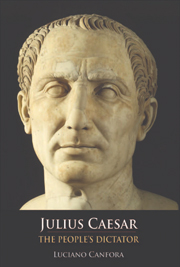Book contents
- Frontmatter
- Contents
- Translators' Note
- Acknowledgements
- Foreword
- PART I FROM SULLA TO CATILINE
- PART II FROM THE TRIUMVIRATE TO THE CONQUEST OF GAUL
- PART III THE LONG CIVIL WAR
- 16 Towards the Crisis
- 17 Striving after Tyranny?
- 18 Attacking the World with Five Cohorts
- 19 Caesar's ‘Programme’: In Search of Consensus
- 20 ‘Amicitia’
- 21 From the Rubicon to Pharsalus
- 22 Against Subversion
- 23 Alexandria
- 24 Caesar Saved by the Jews
- 25 From Syria to Zela
- 26 The Long Civil War
- 27 The Shoot of a Palm Tree: The Young Octavius Emerges
- 28 ‘Anticato’
- PART IV FROM THE CONSPIRACY TO THE TRIUMPH OF CAESARISM
- Chronology
- Bibliography
- Index
28 - ‘Anticato’
from PART III - THE LONG CIVIL WAR
Published online by Cambridge University Press: 05 August 2013
- Frontmatter
- Contents
- Translators' Note
- Acknowledgements
- Foreword
- PART I FROM SULLA TO CATILINE
- PART II FROM THE TRIUMVIRATE TO THE CONQUEST OF GAUL
- PART III THE LONG CIVIL WAR
- 16 Towards the Crisis
- 17 Striving after Tyranny?
- 18 Attacking the World with Five Cohorts
- 19 Caesar's ‘Programme’: In Search of Consensus
- 20 ‘Amicitia’
- 21 From the Rubicon to Pharsalus
- 22 Against Subversion
- 23 Alexandria
- 24 Caesar Saved by the Jews
- 25 From Syria to Zela
- 26 The Long Civil War
- 27 The Shoot of a Palm Tree: The Young Octavius Emerges
- 28 ‘Anticato’
- PART IV FROM THE CONSPIRACY TO THE TRIUMPH OF CAESARISM
- Chronology
- Bibliography
- Index
Summary
With Cato dead at Utica in the manner we know, laudationes of the republican martyr and model Stoic followed one upon another. It was Cicero, with his innate imprudence, who inaugurated the series of posthumous commemorations whose political significance as ‘opposition’ is plain. At the request of Marcus Junius Brutus, Caesar's favourite, but Cato's nephew and admirer, Cicero began writing a Laus Catonis as early as April 46 bc, as soon as the news reached Rome of Cato's suicide in Africa. In the Orator (which followed shortly after), he stresses that the impulse for this came from Brutus: ‘I would never have written it through fear of this age so unfriendly to virtus, had I not considered it base not to yield when you urged so strongly and kindled the memory of one so dear to me.’ And he goes on:
I call you to witness (testificor) that it was because you asked me that I dared, albeit reluctantly, to write this book. For I wish that you should share the reproach with me, so that if I cannot defend myself against so weighty a charge, you may take the blame for imposing an excessive task on me, as I take the blame for accepting it. However, any error in my judgement will be counterbalanced by the glory of dedicating the work to you.
- Type
- Chapter
- Information
- Julius CaesarThe People's Dictator, pp. 256 - 260Publisher: Edinburgh University PressPrint publication year: 2007



